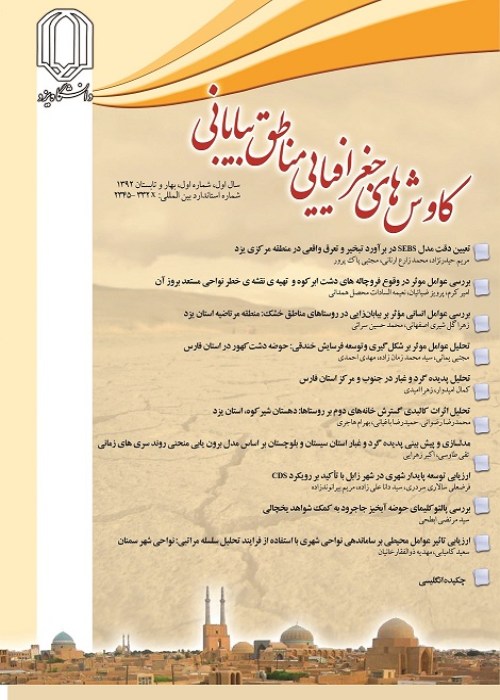Spatial analysis of the pattern of energy consumption in the domestic sector in the neighborhoods of Birjand city
Energy and its consumption pattern are among the basic issues related to sustainable development in urban areas.Today, an important part of research in the field of urban studies focuses on this issue. Meanwhile, in countries such as Iran, due to the cheapness of energy consumption, this issue has received less attention from planners. In a city, an important part of the difference in the energy consumption pattern is explained by the city form and its spatial characteristics. Therefore, paying attention to spatial analysis models and methods can help to understand this issue. Spatial analysis models help the role of spatial differences in energy consumption by using tools and software related to spatial database. Therefore, the present study aims to measure the pattern of gas consumption in the domestic part of Birjand city by relying on spatial analysis methods. The study is descriptive-analytical and research variables include 1) energy consumption, 2) population, 3) building quality, 4) building age, 5) parts size, 6) building facade and 7) urban form. The studied area also includes 5353 residential plots in 5 neighborhoods of Birjand city with different physical, socio-economic characteristics. These neighborhoods include "Zafar", "Bazar", "Sarab", "Edari" and "Resalat". which are located in the north, west, south and east of Birjand city. In the first step, after collecting data related to gas consumption by residential units in each of the studied localities, a spatial database was created in ArcGis. Also, the physical characteristics of each piece were collected in this database. The research variables include gas consumption by 5353 residential plots in the target areas on one hand and physical variables related to the characteristics of each plot including size, building quality, building age, building facade and also the population living in each residential unit on the other hand. In addition to this, the compression index was also considered as an index of texture form, as another variable related to the subject. Further, by using classical statistical methods (correlation coefficient, analysis of variance and Shannon's entropy) and spatial statistical methods (such as density models, two-way Moran and spatial autocorrelation), the findings were analyzed. The results obtained at two macro levels (at the level of all neighborhoods) and local (at the level of residential plots in each neighborhood) are prepared in the form of maps, charts and tables, and finally, by putting the prepared layers together, the data is combined. with each other and the final conclusion was reached The results showed that energy consumption has an inverse relationship with the variables of building age, population and building quality, and a direct relationship with the entropy coefficient. This means that new tissues, in addition to their short lifespan and lower population density, have not been able to be effective in reducing energy consumption. On the other hand, despite the high population, organic tissues show a lower amount of energy consumption. This issue shows the necessity of paying attention to tissue renewal processes and its effect on energy consumption compared to older tissues. On the other hand, it shows that paying attention to the spatial patterns of consumption will be one of the key points in improving the energy consumption pattern. It is not possible to optimize energy consumption and modify the consumption pattern, regardless of the characteristics and spatial differences (even in urban scales). This issue is especially visible in big cities that show a high variety of living patterns and lifestyles. Therefore, setting a single pattern for them is not a good job. As in this study, spatial analysis accurately showed the spatial differences in energy consumption and the different status of physical indicators in each of the target neighborhoods in Birjand city. The general result of this study shows that an important part of the differences in the consumption pattern is explained by the spatial differences. Therefore, the modification of the consumption pattern is an issue that is achieved under the synergy of various specialties. Part of which is related to the understanding of spatial patterns. In this regard, setting up and completing the location database of subscribers and identifying consumption patterns is perhaps one of the most important basic measures, in order to move in the direction of the optimal consumption pattern. In such a way that during this preparation, an accurate picture of energy consumption in different sectors and its relationship with other issues will be clarified. In order to obtain a detailed analysis of consumption and its pattern in its shadow, and adjust appropriate frameworks for each area in line with optimal energy consumption. کلیدواژه ها [English]
- حق عضویت دریافتی صرف حمایت از نشریات عضو و نگهداری، تکمیل و توسعه مگیران میشود.
- پرداخت حق اشتراک و دانلود مقالات اجازه بازنشر آن در سایر رسانههای چاپی و دیجیتال را به کاربر نمیدهد.



